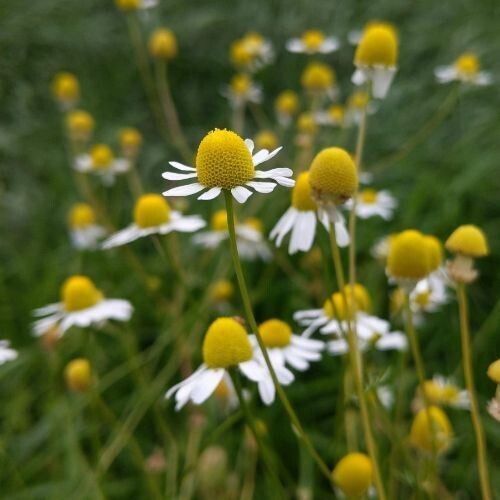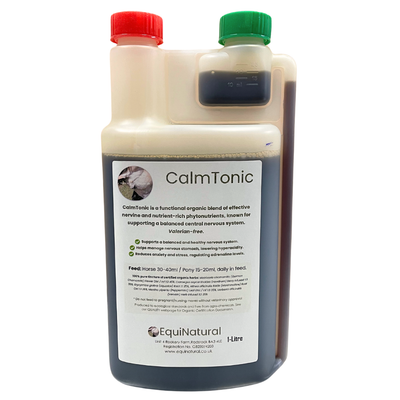ESTABLISHED 2006
Over 50,000 Orders Shipped
NEXT DAY UK DELIVERY
Worldwide Shipping 3-5 Days
SUBSCRIPTIONS
Subscribe & Save!
RATED ★ ★ ★ ★ ★
1100+ 5* Reviews
CHAMOMILE (Matricaria recutita)
Available either as a dried herb or herbal tincture.
Please note this is a nutritional, functional horse food supplement and not veterinary medicine. See Dr Kellon's Horse Sense - 'Nutrition is not 'Alternative' Therapy.
Tincture
Our human-grade, certified organic tinctures give you a ready-to-absorb potent source of phytonutrients at the highest-strength available, for immediate absorption straight into the bloodstream and to the body’s cells.
100% certified organic pure tincture: Matricaria chamomilla (German Chamomile) Flower, Distilled / Infused 1:3 45%, Organic Cultivated
~ Feed Guide
- 6ml/100kg bodyweight, daily in feed.
- Always shake the bottle to disperse any sediment.
- 3-year shelf-life.
Dried Herb
Certified organic dried herb: Matricaria recutita (Chamomile) Flowers , Organic Cultivated, Origin Egypt
~ Feed Guide
- 5g/100kg bodyweight per day, thus for an average 500kg horse add 25g daily to feed.
- 1-year shelf-life.
Functional Nutritional Value
Constituents:
Coumarins (umbelliferone, heniarin), flavonoids (apigenin, apigetrin, apiin, luteolin, quercetin, quercimeritrin, rutin), glycosides, tannins, 0.24-1.9% volatile oils ( -bisabolol (up to 50%), sesquiterpenes, cadinene, farnesene, furfural, spathulenol, matricarin, matricin), amino acids, anthemic acid, choline, polysaccharides, fatty acids.
NB. Our range of botanicals are all grown, harvested and dried without the use of agri-chemicals, non-irradiated and GMO free - see our Quality page for Quality Management & Certification Documents. Laboratory tested for identification and compliance to the British and European Pharmacopoeia standards, and are human grade.
Please be aware that if you're purchasing our dried botanicals for human use, our dried range is cut to appropriate sizes for feeding to horses.
More ...
Chamomile may appear fragile, but it punches well above its weight - it's a potent nervine and powerful anti-inflammatory, and one of the most versatile plants in the herbal apothecary. It's easy to grow, attract pollinators, smells wonderful and makes a great tea. Its funky blue-coloured essential oil is widely used in the pharmaceutical and cosmetic industry, and the aromatic flowers make a lovely addition to lemonades and lemon sorbet. In the tradition of flower symbolism, chamomile represents strength through resistance; this is probably related to the English proverb, " Like a chamomile bed, the more it is trodden, the more it will spread. "
Chamomile is hugely popular the world over as a traditional herbal product used for minor gastrointestinal complaints including bloating and spasms. It's also useful to soothe colds, ulcers, inflammations of the mouth and throat, and topically used to ease irritations and minor inflammations of the skin, such as sunburn, superficial wounds, and as an eye wash.
Chamomile has been used since at least the 1st century for digestive problems, but its use predates written history - chamomile, along with yarrow ( Achillea millefolium ), was found in scrapings from 50,000-year-old Neanderthal teeth discovered in northern Spain. It's also not gone unnoticed that 12th-century abbess and herbalist Saint Hildegard von Bingen (1098-1179) didn't mention the use of chamomile, even though it was a common plant, but it was noted that it was used to make a soup containing oil, butter or lard, water, and flour, to ease constipation and painful menstruation, while the herbal juice mixed with butter was applied to wounds.
From the 16th century onwards, chamomile is frequently mentioned in the herbal literature and its use became so popular that Hieronymus Bock (1498-1554), a well-known German botanist and physician, noted that he was not able to add new information about chamomile because there was no other herb so popular than the cure-all chamomile.
German physician Leonhart Fuchs also liked it enormously - he prescribed it as a tea or a bath to stimulate menstruation and ease flatulence, jaundice and liver issues, alongside eye infections and as a diuretic, while an oil maceration applied as a suppository was indicated in cases of fever and constipation. Interestingly, Fuchs also suggested drinking chamomile tea after being bitten by a viper, but no-one's sure why as he didn't say ...
As an antispasmodic, chamomile relaxes the smooth muscles of the digestive tract, helping to ease cramping and soothe digestive discomforts, and as a mild bitter, chamomile also stimulates gastric secretions and improves the appetite. It's often used as an after-dinner tea to ease heartburn, bloating, and indigestion, and with its carminative, antispasmodic, anti-inflammatory and nervine actions make it a useful support for IBS, colitis, stomach ulcers, diverticulitis, diarrhea, constipation, and other digestive issues.
Chamomile tea has a pleasant taste and is safe for children and babies, often used in cases of colic. It's well known as an anxiolytic, useful for easing anxiety, stress and tension and promoting restful sleep, and it's thought that the inhalation of the volatile oil present in the vapour when drinking tea is partially responsible for the sedative effect, i.e. apigenin (a volatile flavonoid) may bind to benzodiazepine receptors in the central nervous system.
We use a lot of chamomile across many of our gut blends and for its anxiolytic actions - you'll find it in our BiomeTonic , CalmTonic , ColicTonic , GutBitters , MellowMare , PollenTonic , StressTonic & UlsaTonic blends.
Safety
- Chamomile is generally considered safe when taken within the suggested dose and is a gentle herb suitable for during pregnancy and nursing.
- Chamomile may reduce the absorption of iron; in cases of anemia, avoid taking chamomile simultaneously with iron supplements.
The EquiNatural Blog

Menu
Get in Touch
+44 01761 325032
mail@equinatural.co.uk
Unit 4 Rookery Farm, Radstock, BA3 4UL
Terms & Conditions
Privacy Policy
Legal Notice
Stay Connected
Subscribe to our emails for the latest insights, updates, tips, and offers.
Contact us
Thank You for Joining Us!
We’re so pleased to welcome you to the EquiNatural community. Keep an eye on your inbox for updates, tips, and exclusive offers to help your horse thrive naturally.
Warm wishes
The EquiNatural Team
Please try again later
Any information contained within is not intended to replace veterinary or other professional advice.
*
Trading Standards EC Feed Hygiene Regulation (183/2005), Registration No. GB280/4203
* HACCP certified facility (an international standard that ensures we meet food safety standards)
* Registered in England. Company Number 11075894 - Reg'd Office: Unit 10 Rookery Farm, Radstock BA3 4UL
* VAT No. GB 310214964





